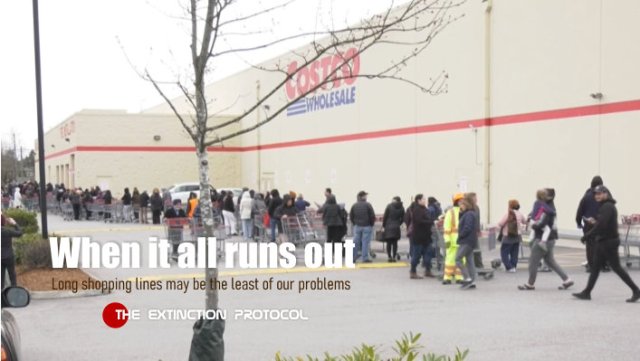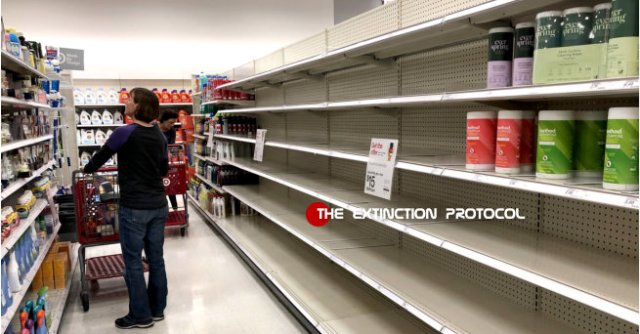Panic Shopping: Grocery supply lines are stretched thin – and disruptions could worsen in the foreseeable future

The companies that feed America and provide basic staples are bracing for labor shortages as the coronavirus pandemic intensifies, which could leave them without enough workers to manufacture, deliver and unpack groceries in stores in the coming months. As the virus spreads, supermarkets and distribution facilities face a difficult choice: how to keep shelves stocked with essentials while keeping their workers safe. Already, some chains are rationing products as shelves empty out of pasta, rice and frozen vegetables and anxious customers wait in long lines for toilet paper and bottled water – in scenes similar to those seen before a hurricane, yet this time unfolding on a national scale.
In Washington, D.C., hundreds of people waited in lines that snaked to the back of stores and sometimes onto sidewalks at Walmart, Whole Foods and Trader Joe’s this week, as consumers stocked up on toilet paper, canned tuna and cartons of pre-made soups. Cases of chicken, beef and frozen vegetables were largely wiped out at a Whole Foods near American University. At the Trader Joe’s in Tampa, Florida, the pasta and tomato sauce aisle was empty Friday afternoon, and the salty snacks were depleted (there was still plenty of $3 chardonnay on offer, however). Food producers and supply chain managers say there is generally enough nonperishable food on shelves, in warehouses and on the production line to last several months, but the challenge could soon be getting that food to the right places once local distribution centers are wiped out.
In addition, millions of Americans, who previously got food at restaurants or in school or at work cafeterias, will have to serve themselves at home, with food bought from grocery big-box enterprises. “The replenishment cycle is going to be the real test here,’ said Sean Maharaj, a supply chain expert and managing director at AArete, a consulting firm in Chicago. “Manufacturers don’t sit on a lot of extra inventory, so what do you do when everything you have is depleted?” Beyond that, industry officials acknowledge some uncertainty about how exactly they will be able to replenish their stocks if factories and ports worldwide are short-staffed. Over the past decade, retailers have moved aggressively to become more efficient by slimming down on inventory instead of stockpiling backrooms.
“We’ve whittled down the inefficiencies to the point where logical and orderly demand creates logical and orderly resupply,” said Mark Cohen, director of retail studies at Columbia Business School and the former chief executive of Sears Canada. “But this is a different situation: This is serial hoarding – and no part of the machine that supplies consumers is geared for this.” There are already signs of far-reaching shortages: Shelves of hand sanitizer and disinfecting sprays have remained empty for weeks across the country. Amazon is largely sold out of toilet paper, with shipments that were due to be delivered earlier this week delayed indefinitely. Costco’s website, meanwhile, is out of peanut butter and canned tomatoes, and has removed its online listing for Kirkland brand baby wipes. Amazon and Costco did not respond to requests for comment. “Either prices will start to go up as we see shortages, or companies will have to figure out new ways to move things around,” said Per Hong, a senior partner in the strategic operations at Kearney, a consulting firm. “Companies can start to pivot, but there is no question we’ll see disruptions because of coronavirus.” –AND

Some store shelves could be completely empty by April: Coronavirus has the potential to become a global pandemic, temporarily emptying retail store shelves in the coming months and depressing some consumer-facing businesses, experts say, with government officials advising families to take measured steps to stock up on certain essentials. Global supply chains running on lean inventories could be vulnerable to disruptions as suppliers are cut off from markets or can’t access critical components or essential ingredients. f production isn’t restarted soon, the bottlenecks could lead to some bare shelves at brick-and-mortar retailers by mid-April, with stores such as Target and Walmart at the greatest risk, Kelly wrote.
Supply chain disruptions and shortages have the potential to hit retailers such as Best Buy, Michaels and Wayfair in the near future, considering that 60 percent to 70 percent of their inventory comes from China. Even Costco, BJ’s Wholesale Club and Kroger could see issues because of China’s role in packaging materials and basic paper products. Retailers have started to look to shift production from China to other parts of Asia, but they are hitting snags because many raw materials come from China. –NBC

Comments
Post a Comment